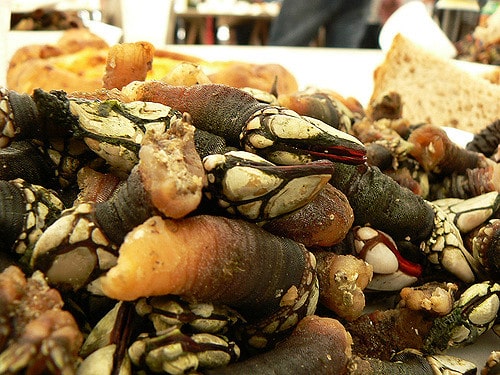Portugal, a country stretching along the ocean, offers us everything the ocean has to offer – beautiful beaches, landscapes and amazing food. It is a veritable paradise for seafood lovers, of which it offers a real wealth. One particularly popular, though almost unknown in Europe, are crustaceans called percebes. Why is it worth trying them? How to eat them? Where do they come from?
Percebes – what is it?

Percebes are marine crustaceans you might see at a fish stand, distinguished from other products by their strange appearance, somewhat resembling the claws of a reptile or dinosaur. They live attached to the hard surfaces of ocean rocks. Extracting them from their natural environment is quite risky, but there are people who do it professionally. Unfortunately, due to the dangers lurking during their harvesting – in order to start fishing you have to wait for high enough waves, because then the percebes “soak” hard enough – they are not among the cheapest seafood. Their price is also influenced by the fact that they are not farmed – all of them of European origin are wild, and it is to this that they owe their unique taste. Below you can watch a video about percebes (percebeiros) catchers with Spanish subtitles.
How to eat percebes?
There are many different opinions on how to properly prepare percebes. Some describe their taste as that of the ocean, to which adding any additives is sacrilege. In such a “raw” version they taste somewhat similar to oysters, being sweet yet delicate. In fact, the taste of the “ocean” – salty water – is noticeable. Still others describe their taste as a combination of clams and shrimp. To taste them in their natural version, simply drop them into salted water and boil for about 2-3 minutes. They can also be eaten raw, simply washed under water – although then the marine origin of the percebes and their intense fishy-salty flavor become very noticeable.
Although they look armored, getting to the inside is relatively easy – just grab the opposite ends and twist in opposite directions. The skin then separates from the rest and the entire “contents” of the crustacean are revealed to our eyes. Some dip it in lemon juice, others add aioli sauce, and most often we just bite the contents.
What are the characteristics of good percebes?
If you are at the fish market and want to choose a good-quality cachaenica, pay close attention to its appearance. Having a choice between those with a long leg and those with a short leg, always choose the one with the shorter one. This means that they grew in harsher conditions, had to resist the waves harder, so their meat is firmer and simply better tasting. In general, the more difficult conditions they live in, the better their taste and, unfortunately, the higher the price. Before buying, make sure that they come from Europe – they are not bred on the Old Continent, which affects the unique taste and firmness of the meat. Some Percebes are imported from the coasts of Mexico or Oregon, where they are industrially farmed on a large scale. Percebes coming from such farms are much cheaper, but taste completely different – all due to the different salinity of the Pacific.
Where can percebes be found?
They were originally found only as a regional delicacy found off the coast of Spanish Galicia, Asturias and especially in the Portuguese Alentejo region. It is there that they are valued the most, which is hardly surprising – they are available fresh, straight from the ocean. However, it is quite an expensive dish – at the market a kilogram costs at least 25 – 30 euros, although those harvested during the biggest storms reach a price of 300 euros per kilogram!
But no worries, every tourist I’ve met has never managed to eat more than a dozen pawpaws. It makes the most sense, therefore, in a restaurant (if you have to deal with the “scale”) to simply choose one handful.

Percebes are my favorite Portuguese delicacy 😀
Persebes as an appetizer for drinks or fatty food – great!
I saw them on a beach in Portugal attached to a rock and wondered what they were.